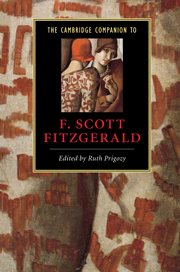Book contents
- Frontmatter
- 1 Introduction: Scott, Zelda, and the culture of celebrity
- 2 F. Scott Fitzgerald, age consciousness, and the rise of American youth culture
- 3 The question of vocation in This Side of Paradise and The Beautiful and Damned
- 4 The short stories of F. Scott Fitzgerald
- 5 The Great Gatsby and the twenties
- 6 Tender is the Night and American history
- 7 Fitzgerald’s expatriate years and the European stories
- 8 Women in Fitzgerald’s fiction
- 9 Fitzgerald’s nonfiction
- 10 Fitzgerald and Hollywood
- 11 The critical reputation of F. Scott Fitzgerald
- Bibliography
- Index
6 - Tender is the Night and American history
Published online by Cambridge University Press: 28 May 2006
- Frontmatter
- 1 Introduction: Scott, Zelda, and the culture of celebrity
- 2 F. Scott Fitzgerald, age consciousness, and the rise of American youth culture
- 3 The question of vocation in This Side of Paradise and The Beautiful and Damned
- 4 The short stories of F. Scott Fitzgerald
- 5 The Great Gatsby and the twenties
- 6 Tender is the Night and American history
- 7 Fitzgerald’s expatriate years and the European stories
- 8 Women in Fitzgerald’s fiction
- 9 Fitzgerald’s nonfiction
- 10 Fitzgerald and Hollywood
- 11 The critical reputation of F. Scott Fitzgerald
- Bibliography
- Index
Summary
In the very young Fitzgerald's first novel, This Side of Paradise (1920), the driving engine was an impulse toward lyricism and extended evocative description - what the fledgling author thought of as “poetic” language, often included for its own sake. In his second novel, The Beautiful and Damned (1922), the driving force changed. The more seasoned young author began to concentrate on objective circumstance and the forward motion of narrative, but the book was less rich in the signature Fitzgerald element of extraordinary evocative power. In his third novel, The Great Gatsby (1925), Fitzgerald's genius, luck, and artistic experience succeeded brilliantly in combining the impelling energies of the first two books. His structural method was the presentation of each concrete event within a progression of related events, a series of meals and parties, by means of hauntingly evocative patterns of language that intricately reflected events upon each other - themes that Fitzgerald called “elaborate and overlapping blankets of prose.” In the process of combining lyrical description with objective circumstance he mastered the connections between themes and narration. He discovered how to build a story out of tightly controlled and intricately woven patterns to express ideas. The expression itself grew from his remarkable power with evocative language.
- Type
- Chapter
- Information
- The Cambridge Companion to F. Scott Fitzgerald , pp. 95 - 117Publisher: Cambridge University PressPrint publication year: 2001
- 6
- Cited by



